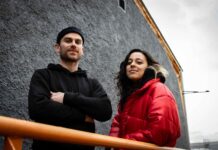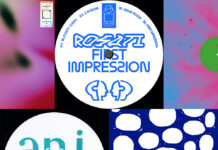Photo: Press (Octo Octa)
There’s been no way around Octo Octa’s breakbeat-leaning House tunes lately. Ever since Maya Bouldry-Morrison in 2011 on the Not Not Fun sublabel 100% Silk, the US American producer and DJ has made a name for herself as a prolific producer. After releasing EPs on Running Back, Deepblak, Skylax and Argot, Bouldry-Morrison debuted on HNYTRX, the explicitly queer imprint of San Francisco’s Honey Soundsystem crew. Where Are We Going?, her first full-length since 2013’s Between Two Selves, thematically focuses on Bouldry-Morrison’s coming out as trans and being seen publicly as a queer woman. Fittingly, Octo Octa’s contribution to our Groove podcast was recorded at a Horse Meat Disco pride party.
You grew up listening to a lot of Drum’n’Bass and started out making experimental music before getting into House thanks to Juan MacLean’s DJ Kicks. What drew you to House music and how did it enter your own productions?
It took me a very long time to understand and accept a 4×4 groove. When I was younger I always felt that House music was too boring to listen to which is what drew me to faster and more kinetic music like Drum’n’Bass. As I got older and began performing in a dance band with my friend Jeremy I finally started to see how a straight-forward beat would make people actually dance at our shows versus my solo performances where people would stand around and watch me play rough IDM or breaks. Then once I heard the DJ Kicks mix things finally clicked and I wanted to try my hand at making slower, more dance-able music.
Before you started DJing, you were first and foremost a live performer. What – or who – convinced you to start DJing?
I was always collecting records, but it took a long time for me to finally be confident to go out and DJ in front of people. I kind of had to start DJing in public out of necessity. I like to think that my first time DJing was when I was in Australia in 2013 with Magic Touch and Bobby Browser. We had to do one gig where I couldn’t play live, so I downloaded a lot of music and threw them on CDs and they showed me very quickly how to use CDJs (I had only spun vinyl at home before that). It was probably a pretty rough set, but once it was over I felt like, “huh, that wasn’t too bad” and then had enough confidence to actually try to do it more. It was that push that got me to finally get out of the bedroom and into the booth.
While you are not keen on sampling vocals for your productions, samples do play a role in your music – most notably, the drum break from Lyn Collins’s „Think“, a staple in Drum’n’Bass. What is your approach to sampling and do you deliberately try to refer to certain musical traditions?
I stay pretty far away from sampling because I like to write almost everything that’s in my tracks. Most of my sampling will be bits of vocals, maybe a single chord then used for a stab, and sometimes drum patterns from old records, like the Think Break for instance. I’m not sure if I really have a set approach when I am using those bits for tracks. Building a track is always a different process for me but breaks are definitely something I come back to pretty often. Listening to breaks and adding them to tracks really gives me a throwback feeling to being a teenager and hearing breaks for the first time. So as long as the sample sounds good in the tune, it doesn’t matter what possible rules there might be for sticking to a musical tradition to use them in.
You have mentioned that Where Are We Going?, your new album recently released through Honey Soundsystem’s HNYTRX, is built around a narrative. Which story is being told throughout the album?
I’m trying to tell a story about being out as trans and being seen publicly as the queer woman I am. The general narrative rides in the track progression and titles so that it moves from point A to point B. Notably the album starts on a cheery note with “Where Are We Going (Part 1)” which ends with a sample of my friend and I at the beach and him asking if there is meaning to life. It then bounces along with ideas of intimacy („On Your Lips“), taking short refuge in happy moments („Fleeting Moments of Freedom“), messages to me as a kid („Promises To A Younger Self“) and then towards the end dips into feelings of being lost („Adrift“) and struggles with balancing happiness amid a world that doesn’t really want you around („Where Are We Going (Part 2)“). There’s more in-depth feelings that are there and I hope I expressed them to the listener which can be tough when working in a mostly instrumental medium.
Apart from Where Are We Going?, you have released or have been involved in five other releases this year alone, by far more than in the previous years. What prompted that recent surge in productivity?
It’s really simple. I finished a lot of records in 2015 and 2016 which didn’t come out until this year! Normally labels are able to get out releases 3-6 months after I send over demos that we like and they want to release. This year happened to be different in that everyone’s schedules all collided around the same time.
One of the records was released by Frendzone, the label associated with the parties you are co-organising in New York. Why did you decide to start the label and what are your plans with it?
My DJ partner and fellow party organizer Kellam Matthews wanted to start it. We had been doing parties together for a couple years and then once Frendzone kind of got set-up it felt like the right kind of party for us (monthly weeknight party!). Kellam is really in charge of the label and I’m super excited to see what he wants to do with it. He has the best ear for sparkly house music; Is one of the few people that will be like, “You should listen to this record” and I love it instantly, plus he’s one of my favorite DJs!
In a recent Groove feature, you have spoken about moving back to your native New Hampshire and have voiced some concerns about the state becoming a more and more libertarian. Is that reflected in the local music scene as well?
I have next to zero idea of what is happening in the local music scene. In most of the state it felt like all there was were funk and hardcore bands playing, but I’m sure I’m wrong. When I was in college though there was an art gallery I went to consistently that had a lot of experimental and noise shows happening and that was very exciting. We’ll see what’s there and how the politics of the scene are. If it consists of the people I went to college with that liked the same music as me, I think I’ll be ok.
What was the idea behind your contribution to our Groove podcast?
The mix is a partial recording of my set at the Horse Meat Disco pride party this past weekend where I broke out a ton of my favorite records that I’ve been playing over the past year. I tried to hold back on too many vocal tracks, but they’re just too much fun to sing and dance along too while DJing!
Last but not least: Where can we see you behind the decks or performing live – and what are your plans as a producer?
I’m playing a lot all over the States and Europe for the rest of the year. I feel like I’m performing every single weekend. As for productions, I’m finally getting myself together after an extended writer’s block and now I’m finishing tracks again. Even though a lot of records came out this year, there is a second 12” based on „Adrift“ from Where Are We Going? coming out in August with remixes from Avalon Emerson and Dorisburg.
Stream: Octo Octa – Groove Podcast 113





